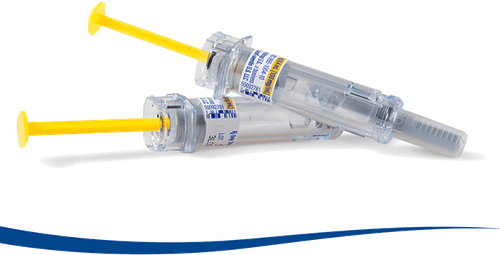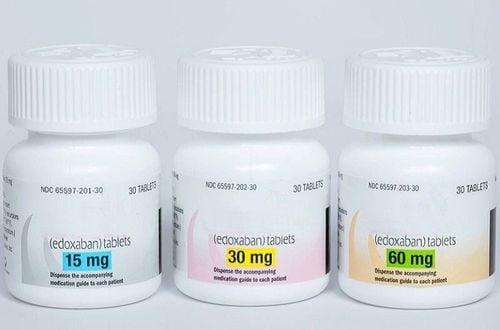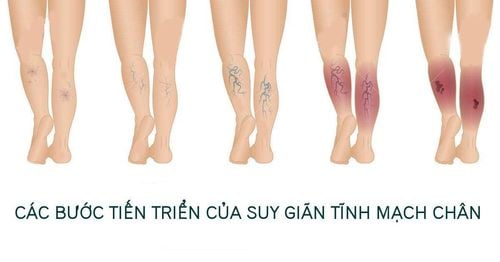This is an automatically translated article.
The consequence of varicose veins of the legs is to increase the pressure inside the leg veins and cause clinical manifestations. The treatment for varicose veins in the legs can be sclerotherapy, surgery or medication,... So what drugs are indicated for the treatment of varicose veins in the legs?1. What is varicose veins of the legs?
Lower extremities have 2 types of veins:
Superficial veins: Located under the skin, visible. Deep veins: Located deep in the muscle, so they cannot be seen. Varicose veins of the legs, also known as varicose veins of the lower extremities, is a condition in which the function of the veins in the legs is weakened, leading to the inefficient blood flow to the heart, causing blood stagnation in the legs. The consequence of varicose veins of the legs is to increase the pressure inside the leg veins and cause clinical manifestations. These symptoms range from mild to severe.
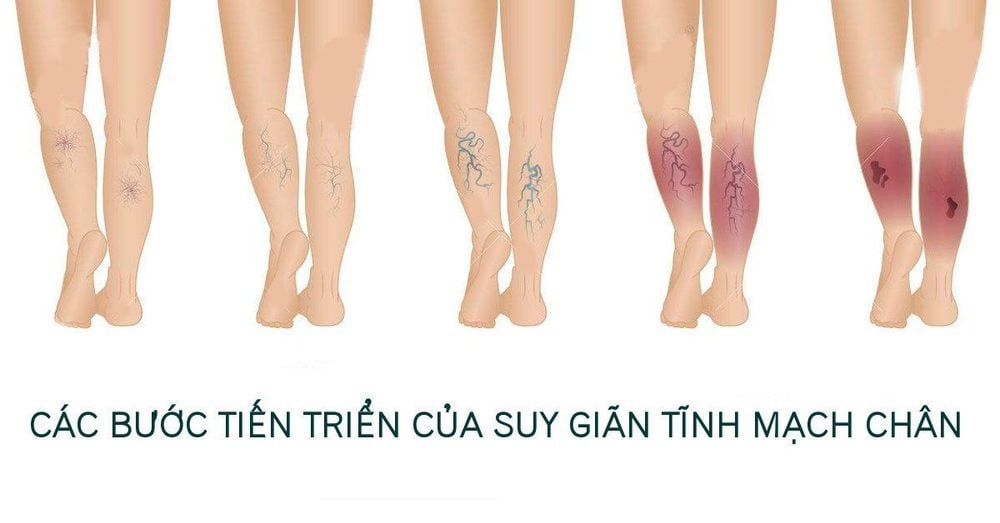
Suy giãn tĩnh mạch chi dưới
2. Causes of leg varicose veins
Causes and risk factors for leg varicose veins:
Having a habit of standing or sitting for a long time causes blood stasis and increases venous pressure of the legs. Deep vein thrombosis blocks blood flow back to the heart. Phlebitis and formation of thrombus in deep and superficial veins Congenital valve defect. In addition, a number of factors increase the risk of varicose veins such as: being a woman with multiple births, being overweight, chronic constipation, using birth control pills, a hot and humid working environment, and lack of exercise. , smoking, over 50 years old, sitting for a long time,...
MORE: Treatment of varicose veins in the lower extremities with laser
3. Symptoms of varicose veins in the legs
Symptoms of varicose veins of the legs usually worsen in the evening, after a day of work or standing for a long time. They usually subside in the morning or at rest, with the legs elevated. Early symptoms and signs of the disease include:
Visible intradermal varicose veins, leg edema, sharp pain in the back of the lower leg, cramps, skin changes, ulcers. For superficial varicose veins, there are usually symptoms such as pain below the dilated area, swollen legs, itching, sometimes dermatitis, green zigzag veins. Patients have a feeling of tightness in the calves, leg heaviness, leg fatigue, sometimes numbness, ants crawling in the foot area. At night, often cramps in the calves and swelling around the ankles. Varicose veins in the legs, if left untreated for a long time, will lead to complications such as the formation of blood clots in the varicose veins, the blood clots can move to the lungs and block the pulmonary veins. , leading to respiratory failure and very easily lead to death if not treated promptly.
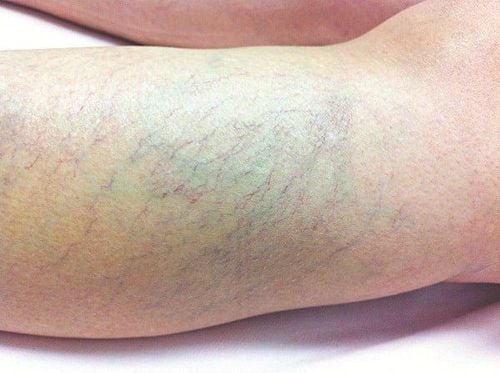
Hình ảnh suy giãn tĩnh chân
3. Treatment of varicose veins in the legs
3.1. Treatment methods Medical treatment: When treating with this method, the patient should limit sitting or standing for a long time; exercise regularly; wear elastic socks; control your weight in a reasonable way; elevating the legs at rest; healthy eating mode. During medical treatment, the doctor will combine with some drugs to treat varicose veins of the lower extremities.
Sclerotherapy: Sclerotherapy is often applied in cases of small and localized reticular varicose veins to treat varicose veins of the legs.
Surgery: Surgery is indicated in case of severe varicose veins or complications that medical treatment has not worked. During surgery, the recurrence rate is low.
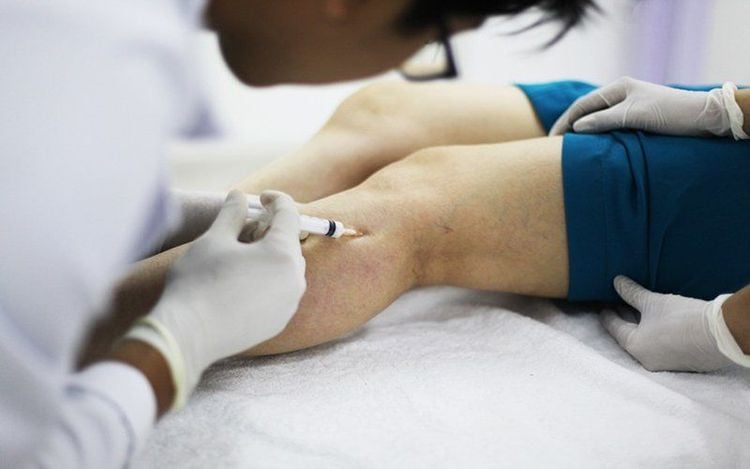
Chích xơ tĩnh mạch chân
Radiofrequency or laser: This method is used for patients with varicose veins of the lower extremities grade 2 or higher or patients who have undergone active medical treatment but have not been effective. When using this method, heat is used to destroy tissue through the friction of ions in the tissue under the influence of alternating current.
MORE: How to reduce varicose veins?
3.2. Medicines to treat varicose veins of the legs The drugs used to treat varicose veins of the legs are the drugs that stabilize the blood vessels, or the drugs that cause sclerosing of the blood vessels, injected locally. Medical treatment with varicose veins such as daflon, rutin C, veinamitol... to stabilize the vessel wall, but mostly only effective in the early stages of varicose veins.
Medicines for varicose veins of the legs to support the treatment process such as: antibiotics, anti-inflammatory drugs, pain relievers, anticoagulants, drugs to dissolve blood clots, drugs to stabilize blood vessels... In some cases, local sclerotherapy may be required with drugs that cause sclerosing of the blood vessel lumen.
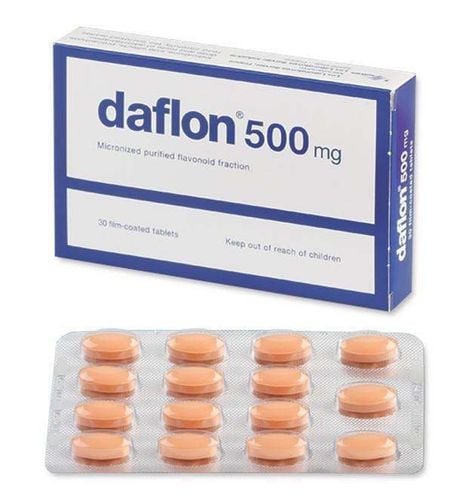
Thuốc Daflon sử dụng trong điều trị suy giãn tĩnh mạch chân
4. Prevention of varicose veins of the legs
To prevent varicose veins, people need to:
Maintain a reasonable weight; Exercise regularly, especially muscle exercises. No smoking; do not drink alcohol. If you have varicose veins in your legs, you should not soak your feet in hot water because it will make your veins more dilated, causing pain... Improve working conditions, avoid standing for a long time while working, dad reasonable rest time. Periodic health check every 6 months to detect early signs of varicose veins..
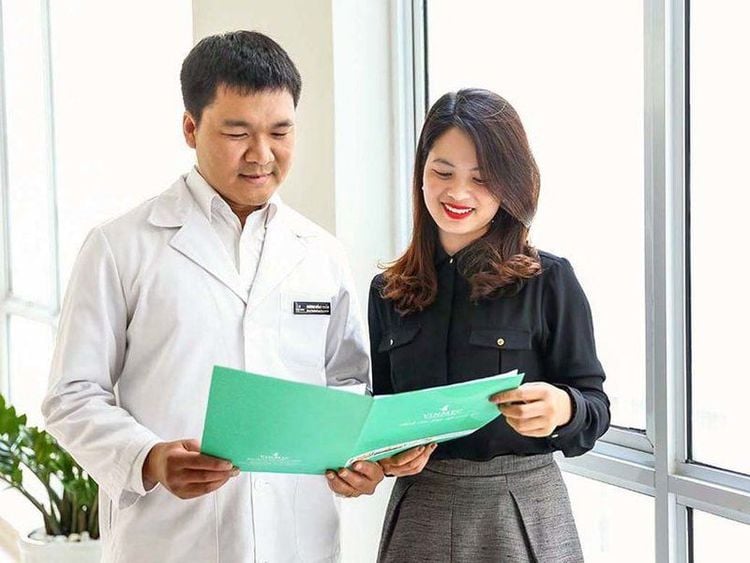
Khám sức khỏe định kỳ 6 tháng 1 lần là việc làm cần thiết
Vinmec International General Hospital now has a package of lower extremity venous insufficiency examination, which helps to determine the causes, complications and levels of venous insufficiency. Subjects using this package include people with the following symptoms:
Small veins on the skin that connect like a spider's web. Superficial veins under the skin are enlarged, running zigzagly close to the surface of the skin, in some cases emerging under the skin. skin becomes large hemangioma Pain, heaviness, and fatigue in the legs Feeling hot, itchy and spastic or cramping at night Numbness, stinging, ants-like sensation in the legs Leg swelling usually occurs in the afternoon or after stand for a while In severe cases, the patient has a change of pigment patches on the skin, the most severe is a necrotic ulcer of a skin area or the entire lower extremity After having an accurate diagnosis of the disease, stage, the patient will be consulted. Choosing the right treatment methods and using the right drugs to improve the quality of life in the future.
>> See also: Varicose veins: What you need to know - The article was professionally consulted by Master, Doctor La Thi Thuy - Cardiovascular Center - Vinmec Central Park International General Hospital.
Please dial HOTLINE for more information or register for an appointment HERE. Download MyVinmec app to make appointments faster and to manage your bookings easily.
Reference source: moh.gov




